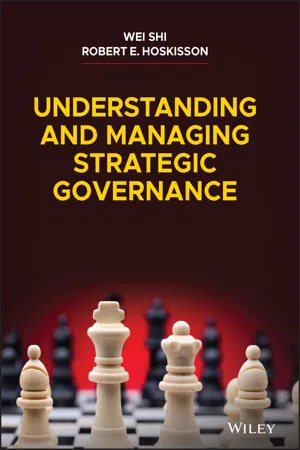
Understanding and Managing Strategic Governance
Wei Shi,Robert E. Hoskisson
- English
- ePUB (apto para móviles)
- Disponible en iOS y Android
Understanding and Managing Strategic Governance
Wei Shi,Robert E. Hoskisson
Información del libro
Explore the interplay between corporate governance and strategic decision-making in this startling new resource
In Understanding and Managing Strategic Governance, strategy and management experts Dr. Wei Shi and Robert E. Hoskisson deliver an insightful exploration of the influence that governance actors, like the board of directors, activist investors, institutional investors, and securities analysts, have on important strategic decisions.
Based on surveying the latest research and analyzing unique datasets compiled by the authors, the book explains the impact that governance actors have on a firm's strategic choices and the quality of such choices as well as the unintended consequences of that impact. The authors also describe how executives can manage the conflicting interests of multiple governance actors and leverage the influence of these actors to make effective strategic decisions.
In this book, you'll discover:
- How to avoid the strategic pitfalls that arise from governance actor influence and harm firms' long-term competitiveness
- The effect that governance actors can have on corporate strategy, competitive strategy, corporate innovation strategy, global strategy, stakeholder strategy, and more
- The latest trends in corporate governance and their implications for managers, regulators, and policy makers in this area
Perfect for C-level executives, board of directors, and institutional investors as well as students of corporate governance and strategy, Understanding and Managing Strategic Governance is a revealing and original examination of the interplay between corporate governance and firm strategy and how to manage that interplay to create sustainable competitive advantages.
Preguntas frecuentes
Información
CHAPTER 1
Introduction to Strategic Governance and Internal Governance Actors
BOX 1.1 Strategic Governance Challenge: Chaos in the Board Room
Índice
- Cover
- Table of Contents
- Title Page
- Copyright
- Dedication
- Preface
- About the Authors
- CHAPTER 1: Introduction to Strategic Governance and Internal Governance Actors
- CHAPTER 2: Introduction to External Governance Actors
- CHAPTER 3: Governance Actors and Corporate Strategy
- CHAPTER 4: Governance Actors and Innovation Strategy
- CHAPTER 5: Governance Actors and Competitive Strategy
- CHAPTER 6: Governance Actors and Global Strategy
- CHAPTER 7: Governance Actors and Stakeholder Strategy
- CHAPTER 8: Governance Actors and Corporate Political Strategy
- CHAPTER 9: Strategic Governance in a New Era
- Index
- End User License Agreement